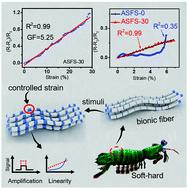当前位置:
X-MOL 学术
›
Mater. Horiz.
›
论文详情
Our official English website, www.x-mol.net, welcomes your feedback! (Note: you will need to create a separate account there.)
Surface structure engineering for a bionic fiber-based sensor toward linear, tunable, and multifunctional sensing
Materials Horizons ( IF 13.3 ) Pub Date : 2020-06-30 , DOI: 10.1039/d0mh00716a Jin Jia 1, 2, 3, 4, 5 , Jun-Hong Pu 1, 2, 3, 4, 5 , Jun-Hong Liu 1, 2, 3, 4, 5 , Xing Zhao 1, 2, 3, 4, 5 , Kai Ke 1, 2, 3, 4, 5 , Rui-Ying Bao 1, 2, 3, 4, 5 , Zheng-Ying Liu 1, 2, 3, 4, 5 , Ming-Bo Yang 1, 2, 3, 4, 5 , Wei Yang 1, 2, 3, 4, 5
Materials Horizons ( IF 13.3 ) Pub Date : 2020-06-30 , DOI: 10.1039/d0mh00716a Jin Jia 1, 2, 3, 4, 5 , Jun-Hong Pu 1, 2, 3, 4, 5 , Jun-Hong Liu 1, 2, 3, 4, 5 , Xing Zhao 1, 2, 3, 4, 5 , Kai Ke 1, 2, 3, 4, 5 , Rui-Ying Bao 1, 2, 3, 4, 5 , Zheng-Ying Liu 1, 2, 3, 4, 5 , Ming-Bo Yang 1, 2, 3, 4, 5 , Wei Yang 1, 2, 3, 4, 5
Affiliation

|
Flexible and stretchable strain sensors have broad applications in human physiological activities, object deformation, as well as human–machine interface. However, it is still challenging to fabricate stretchable strain sensors with linear and superior piezoresistive signal response. Herein, we report a facile and scalable microstructure design strategy to generate a unique segmental hierarchical fiber-surface structure that mimics an arthropod's body and a lobster's tail structure for achieving linear strain sensing response. The alternate modulus difference of the micro-nanoscale segmental soft (thermoplastic polyurethane, TPU)-hard (polystyrene, PS) configurations enables the initiation of significant strain concentration effect, which is consistent with the finite element analysis, thus allowing to tune the sensing properties, for e.g., the linear degree varies from 0.48 to 0.99 and the gauge factor ranges from 5.25 to 23 800 for the strain within 30%. The bionic structured fiber sensors demonstrate potential applications for the detection of human skin epidermal disturbance, small curvature changes, sound wave vibration, as well as mechanochromic response if a fluorescent agent is added to the TPU core. Besides, they are also capable of detecting various types of organic vapors due to the strain amplification effect heterogeneous structure design, paving a new way for the design of multifunctional flexible sensors for variable human–machine interface applications.
中文翻译:

仿生纤维基传感器针对线性,可调和多功能感测的表面结构工程
柔性和可拉伸应变传感器在人体生理活动,物体变形以及人机界面中具有广泛的应用。然而,制造具有线性和优异压阻信号响应的可拉伸应变传感器仍然是挑战。在这里,我们报告了一种灵活且可扩展的微结构设计策略,以生成模仿节肢动物的身体和龙虾尾部结构的独特分段分层纤维表面结构,以实现线性应变感测响应。微纳米级分段软(热塑性聚氨酯,TPU)-硬(聚苯乙烯,PS)构型的交替模量差异使得能够引发明显的应变集中效应,这与有限元分析相一致,从而可以调节感测特性,对于例如,对于30%以内的应变,线性度从0.48到0.99不等,应变系数从5.25到23 800不等。仿生结构化纤维传感器在将人类皮肤表皮干扰,小曲率变化,声波振动以及机械变色响应(如果在TPU芯中添加荧光剂)的检测方面展示出了潜在的应用。此外,由于应变放大效应的异质结构设计,它们还能够检测各种类型的有机蒸气,为用于可变人机界面应用的多功能柔性传感器的设计开辟了新途径。
更新日期:2020-09-01
中文翻译:

仿生纤维基传感器针对线性,可调和多功能感测的表面结构工程
柔性和可拉伸应变传感器在人体生理活动,物体变形以及人机界面中具有广泛的应用。然而,制造具有线性和优异压阻信号响应的可拉伸应变传感器仍然是挑战。在这里,我们报告了一种灵活且可扩展的微结构设计策略,以生成模仿节肢动物的身体和龙虾尾部结构的独特分段分层纤维表面结构,以实现线性应变感测响应。微纳米级分段软(热塑性聚氨酯,TPU)-硬(聚苯乙烯,PS)构型的交替模量差异使得能够引发明显的应变集中效应,这与有限元分析相一致,从而可以调节感测特性,对于例如,对于30%以内的应变,线性度从0.48到0.99不等,应变系数从5.25到23 800不等。仿生结构化纤维传感器在将人类皮肤表皮干扰,小曲率变化,声波振动以及机械变色响应(如果在TPU芯中添加荧光剂)的检测方面展示出了潜在的应用。此外,由于应变放大效应的异质结构设计,它们还能够检测各种类型的有机蒸气,为用于可变人机界面应用的多功能柔性传感器的设计开辟了新途径。



























 京公网安备 11010802027423号
京公网安备 11010802027423号